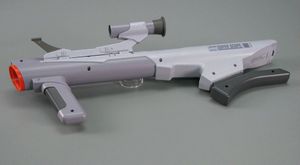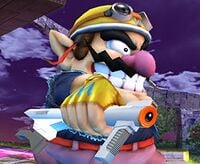Super Scope
The Super Scope is the official light gun peripheral for the Super Nintendo system. A wireless gun that could register shots in the game on the television screen by pointing at it, the Super Scope was the successor to the NES Zapper peripheral, but its bulkier nature coupled with a lack of compatible SNES software ensured it was never successful commercially. It makes its appearances in Super Smash Bros. Melee and Super Smash Bros. Brawl as a battle item.
Item description
The Super Scope was released shortly after the Super NES system itself, released in September 1992 in the U.S. and European markets (the latter as the Nintendo Scope) primarily, with a limited Japanese release caused by a lack of consumer demand. Bundled with the hardware was the software title Super Scope 6, and the full list of SNES games that featured compatibility with the peripheral numbered a notably low eleven: Battle Clash, Bazooka Blitzkrieg, The Hunt for Red October, Lamborghini American Challenge, Metal Combat: Falcon's Revenge, Operation Thunderbolt, Super Scope 6, T2: The Arcade Game, Tin Star, X-Zone, and Yoshi's Safari.
The Super Scope is a light gun-style peripheral that operated for the SNES much like its predecessor, the NES Zapper, operated for the original NES, and it only works with compatible games displayed on cathode ray tube monitors because it makes use of the monitor's display mechanics that involve a scanning electron beam and a photodiode. In light-gun games, you would aim the peripheral at an area of the television screen, pull the trigger, and the game would register where on the physical screen the peripheral was pointed using the cathode ray tube TV's behind-the-scenes mechanics. But whereas the Zapper is shaped like a large gun which is physically connected to the NES with a wire, the Super Scope is a much larger and heftier firearm resembling a vastly undersized bazooka, and it is wireless with a wireless receiver plugged into the SNES' controller slot and placed on top of the television to receive infrared communications from the Scope.
The Super Scope measures just under 2-and-a-half feet long, and is powered by six AA batteries. It is held by gripping the six-inch handle at the peripheral's far end with the non-dominant arm, with the back end shaped to rest on the user's shoulder, and the dominant arm is on the grey area on top of the lower half of the peripheral where three of the buttons on the scope are: the circular Fire button, the pill-shaped Pause button, and a sliding switch that turns the scope off, on, or on in turbo mode. The fourth button is a "cursor" button on the grip handle itself, reachable by the non-dominant thumb. The Super Scope is designed to accomodate users of either dominant arm, which is why the scope's sight component is separate from and attachable to the bazooka on either side. If you're right handed, the sight is attached to the two left clips on the scope's front half so that your right eye can look through it, with your left hand gripping the front handle and the right hand on the buttons on top, and vice versa. The model of the Super Scope as it appears in the Smash Bros. games faithfully preserves all of these aspects.
The Super Scope was never very successful commercially. Critics blasted it as a bulky and cumbersome device that was difficult to use, especially in comparison to its lightweight NES Zapper predecessor. Consumers were also frustrated by the Super Scope's quick battery consumption; the six AA batteries could only last for four hours of continuous gameplay. The ultimate blow to the Super Scope came from lack of compatible software, but whether that lack can be blamed for the Scope's unpopularity or if it was the Scope's unpopularity that can be blamed for the lack of software is hard to discern. The Super Scope was inserted into the software titles Super Smash Bros. Melee and Super Smash Bros. Brawl as an in-game item and was popularized as a result; it may be said that the game industry appreciated the Super Scope as an item in a successful videogame far more than as a tool for playing games. Since its Melee appearance the Super Scope has also cameoed in Mario & Luigi: Superstar Saga for Game Boy Advance as an item used by an enemy, and in WarioWare: Touched! for Nintendo DS.
In Super Smash Bros. Melee
As an item
The Super Scope makes its primary appearance in the Smash Bros. series as a long-range item in Melee, and among the more powerful projectile weapons. First of all, it can be thrown at opponents as a projectile itself, where it will deal 5% - 11% damage if dropped casually and hits an enemy or deal 11% - 18% damage if thrown with force. Like any other projectile weapon, when used for its effect the Super Scope restricts the character to being stationary. It can shoot a total of 48 small shots in rapid succession if the A button is pressed rapidly for about 7 seconds, and each shot is a moderately fast-moving-horizontally yellow orb that travels through an opponent and can hit multiple opponents, and each shot does either 0% or 1% damage with extremely little knockback. If A is pressed sporadically and non-consecutively, each firing will fire a minimum of 3 shots in a row, and 16 such 3-round-bursts are possible.
What makes the item potentially powerful among projectiles is that each shot can be charged up by holding A down. When a shot is charged for any period of time, the resulting orb will become bigger, do more damage and knockback, disappear on contact, and more of the Scope's limited ammo is used up. The specifics of the resulting shot are proportional to the amount of time spent charging. The maximum amount of charging time allotted is roughly a full second, after which the charging Scope will automatically let loose its fully powered shot, which is a large yellow sphere of energy travelling faster than the smaller shots. The fully charged shot can deal anywhere between 15% and 28% damage, and deals a lot of knockback as well. It gradually gets less from 28% the more you shoot fully charged shots. The Super Scope has the ammo reserves to generate three fully-charged Super Scope shots, so 1 fully charged shot takes as much energy as 16 small shots.
The Super Scope's shots can be absorbed by Ness' PK Magnet to heal him, the shots dissipate if they come into contact with a wall but can bounce off angled surfaces that are not particularly steep, and they can be redirected back in the direction whence they came by Fox and Falco's Shine, Zelda's Reflector, Mario and Dr. Mario's Cape, and Ness' forward smashing Bat. These reflected shots can hurt the original shooter; the shots can also be reflected with Mewtwo's Confusion, but it can't hit the shooter. The Super Scope, though its ammo is limited, can gain unlimited ammo through the Infinite Super Scope Glitch, and a spectacular glitch called the Black Hole Glitch involves infinite Super Scopes, a pair of Fox/Falcos, and Peach with her Turnips.
As a trophy
The Super Scope features as a collectible trophy, unlocked as one of the 100+ trophies that can be collected randomly during normal play, such as in the Trophy Lottery and throughout the various Single-player Regular Matches. It reads as follows:
- Super Scope
- A peripheral device for the Super Nintendo Entertainment System, the Super Scope is a wireless weapon that shoots infrared light to a receiver placed on top of the television. In Super Smash Bros. Melee, it can be fired rapidly or charged up to release a more powerful blast. It only has enough energy for 3 charge shots. (Super Scope 9/92)
In Super Smash Bros. Brawl
The Super Scope is confirmed to make a return appearance in Brawl per this update to Super Smash Bros. Dojo!!. It is apparently intact with all its features from the previous game. The Super Scope, with supposedly all other projectile weapons in the game, have received a universal modification, however: Now characters shooting with the Scope can freely move and jump about while in the act of shooting, no longer forced to remain stationary.

